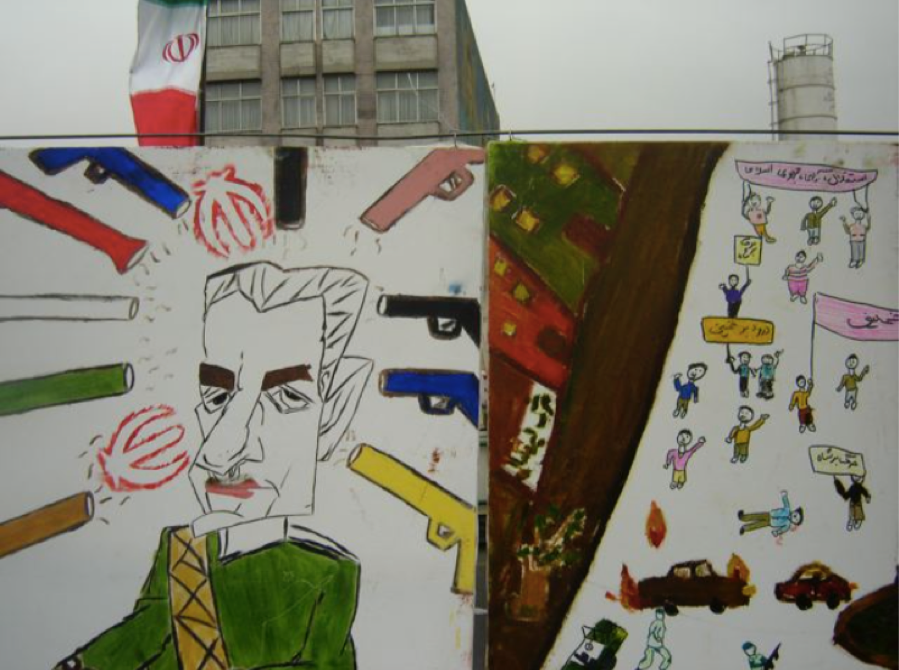Give or take a few thousand years, Iran turns thirty-nine today, February 11. As part of the official commemorations for the anniversary of the 1979 Revolution, or what is known in Iran as the “ten days of dawn” (daheye fajr), state television will broadcast archival footage from that period, including scenes and images unimaginable the rest of the year: There are men with Western ties and women without Islamic hijabs. Secular housewives march in the streets with hezbollahi university students. Jimmy Carter toasts the Iranian monarch in Tehran, and Ayatollah Khomeini meets with American journalists in France.
Every year, the hapless Shah is brought back to life, resurrected by state media only to be chased out of Iran once again, while on another channel Khomeini descends from the sky and into our living rooms on the wings of an Air France passenger plane, returning to Iran after many years of exile. The footage reminds us that revolutions can produce strange combinations, and that our collective memory of those days will forever come in passé hues and sepia tones (will there ever again in history be revolutionaries decked out in wide-collar three-piece suits and feathered hair?).
While we watch this history replayed every year on television, the revolution is not about history. It is a thirty-nine-year old story cut out of sequence, edited back into the programming, and made current. One thing that must be understood about Iran, about living here, is that the revolution is never officially discussed as a finished event. It is transitive, a work still in progress. On its thirtieth anniversary, in 2009, a reporter asked a young man-on-the-street for his opinion about the revolution. The man replied that he wished to be around in ninety years to see the Revolution at 120. One hundred twenty. Such talk is surely dissonant to ears conditioned to think of revolutions as conclusions. It is perfectly normal in Iran.
There are, of course, reasons why the Iranian revolution remains alive. As some have argued, by permanently mobilizing the population, the government can use the revolution to maintain and enhance its rule. While this may be true, I think there is another way to think about Iran’s permanent revolutionary state and the role played by the annual celebrations. Like the mourning rites of Ashura, the revolution must be retold and most importantly, re-enacted. Though revelation comes but once, be it on the plains of Karbala thirteen centuries ago or in the streets of Tehran during the winter cold of 1979, redemption requires the faithful regularly reprise the moment of grace.

So, every year we spool the story back to 1979 and over ten days the state leads Iranian society in public ritual. Public because salvation cannot be achieved sitting alone in the confessional or in front of the television. Turnout is important. Having the masses show up somehow proves that the Islamic Republic is blessed.
The celebrations culminate with a great gathering on February 11, the 22nd of Bahman by the Iranian calendar. In Tehran the crowds converge on Freedom Square, the site of massive rallies during the 1979 Revolution and where millions gathered in June 2009 to demand that their vote be recognized.
While the state organizes the march, it cannot control the meaning people attach to this day. After so many years, the 22nd of Bahman has become as much a national day of gathering as it is a political rally. Television broadcasts the angry speeches denouncing the West, but out in the crowd the atmosphere is often festive. You are just as likely to run into bundled families out for a stroll as you are to find militant basijis marching in formation along the route. The streets are filled with vendors selling food and all along the route are the ubiquitous balloon sellers, men slowly floating through the crowd wrapped in globes of all shapes and colors. It is not uncommon to see people dressed as Mickey Mouse or Winnie the Pooh, pausing to give hugs and take photos with the many children out in the crowd.

We should pay close attention to Khatami’s words. The meaning of the revolution does not belong to one person or group. Rather, the overthrow of the Shah in 1979, like the 2009 demonstrations or the protests that gripped much of the country last month, represent constituent parts of a public and ongoing struggle for democracy in Iran that reaches back over 100 years. It is a mistake to think citizens protest because they reject the regime and revolution. Instead, they march because they too seek redemption. For them as it is for the authorities, the revolution is not yet over but remains a work very much in progress.






